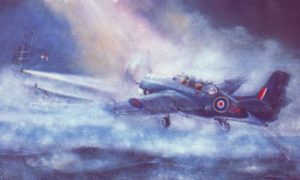- Author
- Mackinlay, Gordon Angus
- Subjects
- Biographies and personal histories, Ship histories and stories, WWII operations
- Tags
-
- RAN Ships
- None noted.
- Publication
- September 2005 edition of the Naval Historical Review (all rights reserved)
HMS Nabob started life in Tacoma, Washington shipyard as a merchant vessel, converted to a Lease-Lend escort carrier, and the first flat-top to be manned by Canadians. On August 22, 1944, the carrier took part in Operation Goodwood, an attack by the Fleet Air Arm on the German battleship Tirpitz in a Norwegian fiord. At 1716 and some 70 miles off the Norwegian coast, Nabob was struck on the starboard side by a torpedo, which blew a 15 metre hole directly beneath the ship’s galley, aft of the engine room. The carrier listed 7 degrees to starboard and down by the stern, and Captain Horatio Nelson Lay gave the order to prepare to abandon ship. At 1724 a second torpedo, intended also for Nabob, hit the stern of the frigate HMS Bickerton, killing more than 40 men. The U-boat fired a third torpedo but missed both crippled ships.
Under orders to abandon and scuttle the carrier if unable to steam, Captain Lay and his crew managed to get under way at 6 knots, despite the gaping hole in the ship’s side. Nabob set off towards Scotland, about 1,100 miles to the west, pursued by a U-boat and trailing oil all the way.

During this epic escape from destruction, another feat of supreme skill and daring was performed by one of her aircrew. The CO of 852 Squadron (LCDR R E Bradshaw, DSC, RN) volunteered to be catapulted off the flight deck in his Avenger and circled Nabob for 4 hours, keeping the U-boat down. As he came into land, fog closed down and all he could see was Nabob’s masthead and the loom of the bridge searchlight. He was almost out of fuel and had only one chance to land. He floated up the flight deck and crashed into six aircraft parked on the forward section, writing them all off, but surviving himself.
About half the ships company of 840 were transferred to accompanying escorts HMS Kempthorne (a sister ship to Bickerton) and the destroyer HMCS Algonquin. Those who remained onboard the escort carrier spent five sleepless days and nights on short rations of potatoes and bully beef. This deprivation was made somewhat the more palatable by the recovery of a 10 gallon keg of rum.
To the amazement of senior Navy personnel, Nabob arrived safely in Scottish waters. The celebration by the ship’s officers and crew was muted by a grisly chore – the collection and removal of casualties. Dockyard mateys refused to perform the hideous task. Twenty one men had been killed by the torpedo and their remains still lay below decks.
“Our chaps each had a stiff noggin of whisky or rum and handed the bodies up, deck by deck”, Captain Lay later wrote in Memoirs of a Mariner.
HMS Nabob did not survive for long. Although the ship had staggered gamely back to home waters, the Admiralty decided that she was beyond repair. In 1947 the ship was towed away to be broken up in the Netherlands. However, she had the last laugh. Somewhere along the way, a marine architect saw something of the ship’s early promise and had her converted back to merchant service. Renamed, SS Glory, she sailed for about another 25 years until finally broken up for scrap in Taiwan.
LCDR Bobby Bradshaw, DSC** was one of the great personalities of the wartime FAA. Entering the FAA as a Midshipman in 1939, he joined 826 Squadron and within 3 years was its Commanding Officer, at 21 the youngest lieutenant commander the Navy has ever known. Flying continuously from the beginning to the end of WWII he was awarded the DSC and two Bars, and Mentioned in Despatches three times, but he was frequently in trouble with higher authority. When stationed in the Western Desert (Sahara) he borrowed a Hurricane from the CO of a forward RAF airfield for a couple of practice circuits, but spotting a German fighter, he shot it down. This created a problem as (a) he was supposed to be on leave and (b) he was not authorised to fly Hurricanes, not having done a conversion course. So he credited the CO with the “kill” and hastily flew back to the fleshpots of Cairo before his absence was noted.




